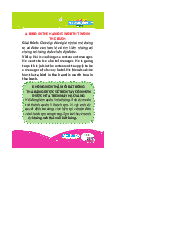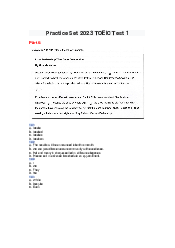



Preview text:
In the busy streets of Male, the capital of Maldives, Aminath Waheed picks up passengers,
blazing a trail as the city’s only female taxi driver. In the hills of Nepal, 30-year-old Madhukala
Adhikari works as a mobile mason, helping families rebuild houses that were destroyed in the
2015 earthquake. And in Chittagong, Bangladesh, Morsheda Begum is a garment worker turned
successful entrepreneur, running her own tailoring shop and supporting her school-aged boys.
Aminath, Madhukala and Morsheda are examples of how when women gain access to
economic opportunities, the benefits are exponential. Women who make money are able to
invest in the well-being of their children and families, contribute to their communities, and help grow economies.
There are millions of such inspiring, independent women across South Asia—especially in the
poorest countries, which are served by the World Bank’s International Development
Association (IDA). They exemplify why closing gender gaps is essential to reducing poverty and boosting shared prosperity.
Over the last few decades, IDA has been supporting countries in South Asia to open up more
economic opportunities for women. Countries like Bangladesh and Nepal have increased
female labor force participation. Bangladesh has also achieved gender parity in both primary
and secondary school enrollment. South Asia has implemented laws that have improved
opportunities for women and gained ten points on the Women Business and the Law index over
the last decade. For example, Nepal recently passed laws to prohibit gender discrimination in employment.
The COVID-19 pandemic, however, threatens to reverse some of these gains in women’s
accumulation of human capital and economic empowerment. School closures meant that
millions of students –especially girls—lost out on learning opportunities for months at a time.
Evidence from Bangladesh suggests that girls are more likely to be spending increased time on
household chores and childcare since COVID-19 restrictions began.
"As countries in South Asia build back from the pandemic, it will be critical to ensure reforms
that close these gender gaps, with impacts that will endure beyond the pandemic."
Lockdowns also disrupted economies and labor markets, resulting in significant job losses for
women and unequal division of labor at home. In Bhutan, the unemployment rate is at an all-
time high of 5%. Women accounted for more than half of this figure even in 2019. In
Pakistan, over a quarter of female workers have been fired or suspended from their jobs in various sectors.
The economic slowdown is also likely forcing families into difficult situations. Child marriage
continues to be prevalent, undermining girls’ education and future opportunities. Gender-
based violence (GBV) also rose – in Nepal, a 24-hour GBV helpline received twice the number of
calls related to domestic violence during one pandemic lockdown period.
It’s important to note that many of the obstacles to women’s economic participation are long-
standing and pre-date the pandemic. For the most part, formal sector employment remains
inaccessible to women. Women in South Asia work mainly in subsistence agriculture, which is
low-paid, unskilled and extremely vulnerable to climate change. The majority of women don’t
have access to finance or even bank accounts. In Pakistan, for example, only 7% of women over
the age of 15 have a bank account, compared to 35% of men. Even before the pandemic, barely
18% of South Asian businesses were owned by women – the lowest rate among global regions.
As countries in South Asia build back from the pandemic, it will be critical to ensure reforms
that close these gender gaps, with impacts that will endure beyond the pandemic. This means
closing gaps in health, education, and social protection; removing constraints to women
accessing more and better jobs; eliminating barriers to ownership; and enabling women’s voice and agency.
Continued IDA support has been instrumental: supporting employment opportunities for
women, closing gaps in digital technology, expanding childcare, and increasing financing for
prevention of and response to gender-based violence.
In Pakistan, the IDA supported Benazir Income Support Program provided cash transfers to over
5.8 million women heads of households, benefiting 30 million family members. In the Maldives,
IDA provided over $27 million income support to more than 22,000 workers who lost their
incomes due to the pandemic, especially vulnerable women who work in the informal sector. In
Bangladesh, stipends and tuition fees were provided to 2.6 million secondary school female
students to ensure their continued education during the pandemic.
Next month, as IDA shareholders convene in Tokyo for a historic early replenishment of the
multibillion-dollar fund, gender and the disproportionate impact of COVID-19—and most crises
—on women should be atop minds. Through IDA, the World Bank stands ready to provide
targeted, comprehensive, and readily available support that empowers women —and, in turn,
their communities and economies for generations to come.
As soon as South Africa announced the spread of a new and troubling variant last week, scientists went to work.
By the time the World Health Organization had named the new lineage Omicron,
multiple teams of researchers had already duplicated the work of the laboratories in
Durban and elsewhere, and mapped out the genetic changes that made Omicron the
new bad actor of the coronavirus family.
Although many of those mutations were familiar from other variants, scientists still were
not sure whether they make Omicron substantially different from previous variants --
especially the super-dominant Delta variant.
It will take weeks of testing to tell what added superpowers, if any, these mutations give Omicron.
Researchers will look at what's happening in the real world by testing samples taken
from patients, sequencing their genomes to see if it's Omicron causing the infections,
and looking to see if more and more samples turn out to be Omicron.
They'll also watch to see if Omicron infections lead to more severe disease and if fully
vaccinated people end up more likely to become infected with Omicron variants as opposed to other strains.
That kind of in-real-life testing can take months.
"AstraZeneca is also already conducting research in locations where the variant has been
identified, namely in Botswana and Eswatini, that will enable us to collect real world data of
Vaxzevria against this new virus variant," a spokesperson for the vaccine maker said Friday.
Vaccine makers are turning to what's become a go-to technique throughout the pandemic --
pulling blood from vaccinated volunteers and people who have recovered from recent
infections and mixing it with samples of the new variant -- or a lab-engineered version called
a pseudovirus -- to see how immune cells and proteins work against it.
Blood serum contains the antibodies and the B cells and T cells that do the hard work of the body's immune system.
Pfizer and its partner BioNTech, Moderna, and Johnson & Johnson all say they're starting these experiments.
"The Company is testing blood serum from participants in completed and ongoing
booster studies to look for neutralizing activity against the Omicron variant,"
Johnson & Johnson said in a statement Monday.
This approach has been used to demonstrate first that vaccines were likely to
work to protect people against infection, then to show they worked to protect
people against the Alpha, Beta, Gamma and Delta variants, and, finally, to provide
the first evidence of waning immunity.
Such lab-dish techniques, combined with real-life evidence, form the basis of
decision making on vaccine authorizations, approvals and guidance on their use.
And they'll be used to inform the world about the risks of Omicron.
"There's two ways we're going to figure this out," National Institutes of Health
Director Dr. Francis Collins told CNN Monday.
"One is by laboratory experiments. To do that, you need to actually have an
isolate of Omicron growing in the lab and then you mix that with serum from
people who've been vaccinated and ask does that vaccinated serum still
neutralize the virus. That just takes a while for the virus to be grown up. There's
not a lot we could do to accelerate that."
World Health Organization Covid-19 Technical Lead Maria Van Kerkhove told CNN
it will take some time to "grow up the stock" of the virus to do that. "Our estimate
is between two and four weeks," she said.
Dr. Anthony Fauci, director of the National Institute of Allergy and Infectious
Diseases, outlined the two approaches Tuesday.
"One of the things you do is you get the virus and you grow it or you put it into a
modified form called a pseudovirus. And when you do that, you can then get
convalescent plasma, monoclonal antibodies, as well as sera and antibodies that
are induced by the vaccine to see if they neutralize the virus," he told a White
House coronavirus briefing. Convalescent plasma comes from people who have been infected and recovered.
"That will give you a pretty good idea as to what the level of immune evasion is.
That process will take likely two weeks or more, perhaps even sooner, depending
upon how well the virus grows in the isolates that we get," Fauci said.
"And in those countries in which there are a lot of cases like South Africa, the
computational biologists and the evolutionary biologists are going to be getting a
good feel as to what the competition of this virus would be with Delta. Those are
just a few of the things that will take a couple of weeks to a few weeks to learn."
US Food and Drug Administration acting commissioner Dr. Janet Woodcock said in
a statement Tuesday the agency is working with medical product companies --
those making tests, therapeutics and vaccines -- to address any potential effects of new variant.
"Historically, the work to obtain the genetic information and patient samples for
variants and then perform the testing needed to evaluate their impact takes time.
However, we expect the vast majority of this work to be completed in the coming weeks," Woodcock said.



